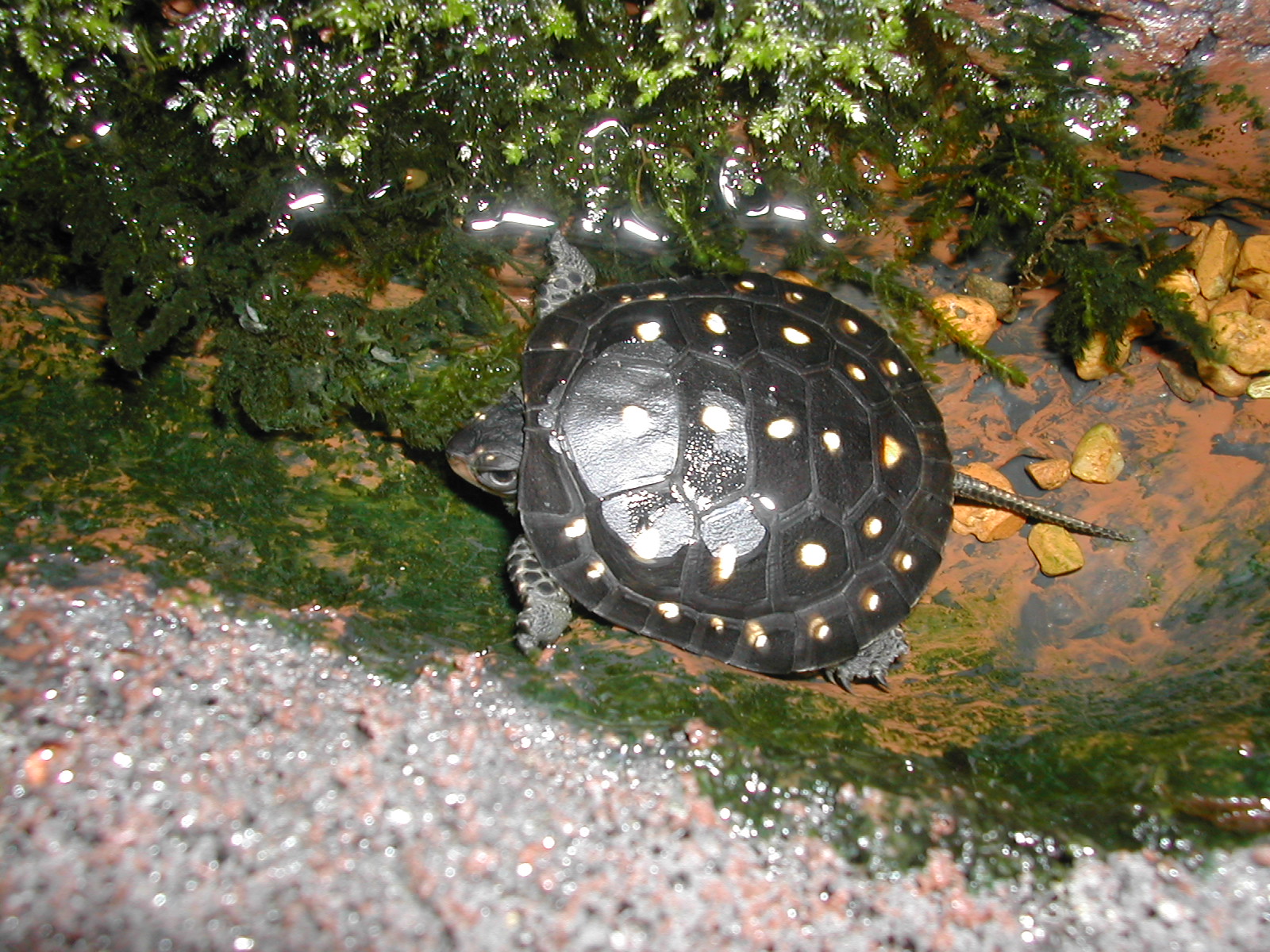Spotted Pond Turtle - Clemmys guttata
American Spotted Pond Turtle

Clemmys guttata
The spotted pond turtle is a relatively small (3.5 to 5"), attractive turtle. Physical characteristics include a steel grey, or more commonly black, keelless, unserrated carapace which is usually sprinkled with varying numbers of small, round, yellow dots. The head and limbs of spotted turtles may also have some degree of yellow and/or orange colored spots and blotches. Plastron color is usually yellowish with large, black blotches occuring in various arrangements. Completely black plastrons are not all that uncommon, and individuals lacking carapacial spots have also been reported. Among the more common physical characteristics used to help determine sexual dimorphism in turtles (length of tails and plastron concavity), chin and eye color can also be used to determine the sex of spotted turtles. Males have brown eyes and tan colored chins, whereas females have orange eyes and yellow colored chins.
Spotted turtles occur in a variety of aquatic situations ranging from shallow, muddy-bottomed streams, to marshy meadows and bogs, to vernal, woodland ponds. The one characteristic that all spotted turtle habitats have in common is shallow water - never more than 24 to 36" deep. The reason for this is that spotted turtles, as aquatic as they may be, are very poor swimmers. Clemmys guttata can be found from southern Maine, southward to Florida along the Atlantic coastal plain with a westward band through Maryland, Pennsylvania, and southern New York, into northern Ohio and Indiana, northeastern Illinois, southeastern Wisconsin, southern Michigan, and Ontario. Population densities tend to become rather sparse in western portions of its range, and there is some debate as to whether any viable spotted turtle populations actually exist in the state of Illinois, where it is listed as an Endangered species.
The spotted turtle, like its two other northeastern relatives, is a true, cold-weather turtle. Spotted turtles are among the first chelonian species to emerge from hibernation in early Spring - often while there is still snow on the ground. They can be seen basking along with other species such as the painted turtle and the bog turtle. Courtship and mating occurs from early March through to late May. Mating in Clemmys guttata is no where near as intense as with wood turtles. As in many turtle species, males will often perform a series of head movements to which the females will often respond to with similar movements. Once a female has acknowledged a male, he will clumsily attempt to mount her and "ride" on her back as she swims and copulation takes place. Males will mate with more than one female and vice-versa. Female spotted turtles have a peculiar ability that has been proven to occur in only a few other turtle species. They can "store" sperm obtained from successful copulations and use it as many as five (documented) years later to produce healthy, fertile eggs. This gives spotted turtles from locations with sparse populations an advantage. Should a female successfully copulate with a male on one occasion, she can, quite possibly, be able to produce fertile eggs for as many as five years without ever seeing another male.
Gravid females normally lay beginning in late May through to early July. Females originating from vernal, woodland pools will often travel great distances to find a suitable, sandy-loam based nesting site which is usually no more than a roadside enbankment. They will dig a small, flask-shaped nest with their hind legs and begin to deposit anywhere from 2 to 8, 1 1/4 inch, elliptically shaped eggs. Captive females have been known to lay two or three, smaller clutches in a given season, although my reasoning for this leans more towards improper nesting conditions than "super-fertility." General incubation time takes anywhere from 60 to 80 days depending on temperature and location. If spared from the grasp of the many scavangers which would love to make a meal of them, tiny neonates will emerge from the eggs in late August into early September. In many cases, hatchling spotted turtles will overwinter in their nests until the following Spring.
Neonate Clemmys guttata display one, small, yellow spot at the center of each scute. If genetically predisposed, spotted turtles will begin to develop more spots at 3 to 4 years of age and older. Size, number, and placement of spots varies greatly. I have seen adult turtles who retain the one, small spot per scute arrangement, as well as individuals who display larger, more numerous, but evenly spaced spots. I have even seen individuals whose black, background color was completely mottled with tiny, yellow specks. Then there are those who lack spots altogether (melanistic?).
Adult and neonate Clemmys guttata share identical diets. Both are primarily carnivorous, taking a wide variety of prey items including tadpoles, earthworms, fish, crustaceans, salamanders, and a variety of insects. Captive neonates can be started on various prefabricated, highly nutritious turtle diets, my favorite of which are Reptomin and Turtle Brittle, and can then be slowly weaned onto live foods. Captive adults are usually very stubborn and will not take prefabricated foods. Large female spotted turtles have been offered and reported to take pinkie mice as an added supplement during nesting season.
Back to TurtleGuy |
Wood Turtle |
Bog Turtle |
Mediterranean Tortoises |
Links